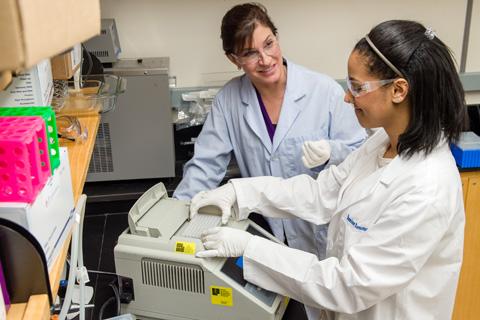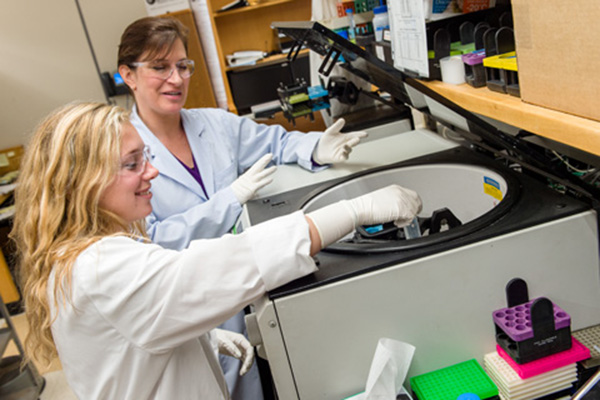You don’t really know something until you can teach it to someone. Raul Cachau said he believes this is not only true in academia, but in research laboratories as well. He said that being a mentor means rediscovering things long taken for granted.
“It really forces you to rethink some of the things you do,” said Cachau, Ph.D., principal scientist, Advanced Biomedical Computing Center (ABCC). “It brings focus to many of the things that happen on a daily basis … There’s a positive impact to taking a fresh look at something.”
In 25 years, the Werner H. Kirsten Student Internship Program (WHK SIP) has blossomed from six interns in the first session, to 70 in the current group. The program has gained popularity by giving students a research experience that is not offered in high schools. While 70 interns is a tremendous growth, Marsha Nelson-Duncan, educational outreach specialist, Office of Scientific Operations (OSO), shared that more than 100 well-qualified applicants missed out on this opportunity because there were not enough mentors.
Nelson-Duncan, who manages the WHK SIP, said it would be great if the program could find a mentor for each qualified student applicant.
How it All Began
In 1990, Howard Young, Ph.D., now a senior investigator, Cancer and Inflammation Program, was approached by NCI administrator Gordon Cecil about an idea to bring high school students entering their senior year to work in labs. He sought input from other NCI investigators, Tom Schneider, Ph.D., now a senior staff scientist in the Gene Regulation and Chromosome Biology Laboratory, and Nancy Colburn, Ph.D., scientist emeritus in the Basic Research Laboratory. They thought, “Why not?” and were eager to see the students’ capabilities. According to Young, the 16- and 17-year-olds did not disappoint.
The original six mentors trained their interns in fundamental laboratory procedures, creating extra time for scientists to conduct more elaborate experiments. In Young’s lab, interns genotyped mice, allowing the lab members to increase their research pace.
Year after year, mentors bring past interns back into the lab during the summer to continue their research and help train the new class of interns. This cycle helps mentors bring new interns up to speed, as former interns can relay their knowledge.
Returning interns bring new knowledge from their college classes that they can apply to the ongoing research of their mentors. By accumulating research experience, they become not only interns, but collaborators as well.
“We are training the future generation of scientists,” Young said. “If you’re not willing to help further scientific education, then part of your responsibility isn’t being met. Sitting in your lab and being a silo is not going to get you anywhere.”
Evolution of Dry Lab Opportunities
The WHK SIP has been seen as an opportunity for promising high school students to do hands-on work at a lab bench, but there are more ways to contribute to the NCI mission. Students can also learn through a dry lab experience, where they work in a non-laboratory environment in support of scientific research. For example, as next-generation DNA sequencing rose in biomedical research, the ABCC was understaffed. This past summer, more than 30 interns worked in the center.
Cachau, who heads the Advanced Structure Analysis Collaboratory at ABCC, sees the value of his interns. “Interns pose new questions that open new possibilities. If we don’t have them here, we know we will have a net loss.”
Former WHK intern Colin Burr worked in the ABCC from 2013 to 2014, where he amplified his passion and talent for computer programming. He developed a project-tracking system that displays milestones, dates, data, and updates. The system is currently in use at the Laboratory Animal Sciences Program and ABCC, and is viewed as a valuable asset. Burr returns to the ABCC during the summer and over school breaks.
Jim Cherry, Ph.D., scientific program director, OSO, believes that interns like Burr are what make the time investment worth it.
While bioinformatics and computer programming are the original dry lab internships, more internship opportunities may be offered in support services. In fact, Cherry anticipates dry lab interns to double the amount of wet lab interns in the near future. The current dry lab opportunities are in the Leidos Biomedical Research Data Science and Information Technology Program, Office of Public Affairs, and Conference Center, as well as the NCI OSO. Cherry said new dry and wet lab areas that the program could spread to include veterinary medicine, Data Management Services, and the Environment, Health, and Safety Program.
New Pilot Program Takes Off
This year, the WHK SIP started a pilot program, almost accidentally, from two initial dry lab interns who showed interest in laboratory research.
Melissa Porter, OSO, and Kim Klarmann, Ph.D., Hematopoiesis and Stem Cell Biology Section, collaborated to create a unique experience for WHK interns Yasmine Boumaiz and Nicole Pohida. Boumaiz and Pohida alternate their days between conducting stem cell research in Klarmann’s lab and creating lesson plans about stem cells and other research for local middle schools with Porter in the OSO. After completing their lesson plans, the interns will present them to middle school students and ultimately post them online for science teachers to use.
The pilot program does not only apply to interns working in the OSO and Hematopoiesis and Stem Cell Biology Section; interns can sequence data in many wet labs and analyze the data in a dry lab. It is up to the mentors if the pilot program will continue next year.
Cachau believes “a joint wet lab/dry lab experience will be more prevalent in the future to acquire information and then process it.”
Participating in the program requires Klarmann to plan ahead, but when asked of its benefits, Klarmann responded, “Isn’t it addictive to talk to a young person who’s so interested? It’s absolutely invigorating.”
Looking Toward the Future
The WHK SIP has expanded from Frederick County Public Schools to Carroll County Public Schools, Washington County Public Schools, northern Montgomery County Public Schools, and private schools, and to home-schooled students. Broadening its availability to students allows the program to bring in a more diverse group of interns, but ideally, the program would like to bring in every qualified intern who applies.
The current wet lab to dry lab ratio is 3 to 1, but hopefully the ratio will be closer to equal “… if anyone who can be a mentor takes a student,” Cherry said.
Mentoring is a vital experience for scientists because it allows them to demonstrate their substantial knowledge of a subject or specific technique, Cachau said. It also helps scientists solidify their skills because interns can provide new perspectives.
“Having an intern forces you to face new problems, adds focus, and clarifies tasks,” Cachau added. “Young individuals add creativity by having a fresh slate from which to look at an issue.”



